Seismic Dynamic Response and Lining Damage Analysis of Curved Tunnel under Shallowly Buried Rock Strata
Abstract
1. Introduction
2. Theoretical Introduction
3. Methodology
3.1. Project Overview
3.2. The Laboratory Experiment Process
3.2.1. Preparation of Materials Similitude, Relations Confirmation, and Derivation
3.2.2. Surrounding Rock and Tunnel Lining Model
3.2.3. Experiment Schemes and Monitoring Instruments
3.3. Numerical Simulation Method
3.3.1. Elaborated Evaluation on the Seismic Performance of a Curved Tunnel
3.3.2. Input of Seismic Waves
3.3.3. Modeling and Parameter Assignment
3.3.4. Calculation Condition and Monitoring Schemes
3.4. Validating Results Analysis and Comparisons
4. Analysis
4.1. The Difference between Deformations of the Curved Tunnels and the Straight Tunnels
4.2. Lining Damage Analysis
4.3. Displacement Analysis
5. Discussion
5.1. Evaluation Coefficient of Curved Tunnel Damage
5.2. Sensitivity Analysis of Variables
5.3. Multivariate Regression
6. Conclusions
- (1)
- Compared with straight tunnels, the curvature of curved tunnels caused the curved tunnels to experience radial deformation and tangential deformation and susceptibility to damage at the arch waist.
- (2)
- Curved tunnels under different surrounding rock strata have the same special deformation pattern during excitation, i.e., the damage changes in a cyclic manner, and the damage does not co-occur, due to a certain hysteresis of seismic waves in the tunnel.
- (3)
- The displacement of the curved tunnel is related to its compressive damage. The lining displacement parameter can be used to quantify the extent of damage to the tunnel structure. The extent of tunnel damage can be assessed by continuously monitoring the deformation of the tunnel. The curved tunnel must be strengthened when the displacement is greater than 76 mm.
- (4)
- Different parameters determine the seismic properties and the degree of damage of the bent body, and they have different effects on tensile and compressive damage. The modulus of elasticity has the greatest effect on tensile damage, while Poisson’s ratio and cohesion have the least effect on tensile damage. Friction angle has the greatest effect on compressive damage, and Poisson’s ratio has a smaller effect on compressive damage.
- (5)
- The multi-factor assessment formula that was produced directs the surrounding rock reinforcement following the geological circumstances and contributes to the appropriate support for a curved tunnel. The method is generic, although its application conditions have some restrictions.
Author Contributions
Funding
Institutional Review Board Statement
Informed Consent Statement
Data Availability Statement
Conflicts of Interest
References
- Song, D.; Liu, X.; Chen, Z.; Chen, J.; Cai, J. Influence of Tunnel Excavation on the Stability of a Bedded Rock Slope: A Case Study on the Mountainous Area in Southern Anhui, China. KSCE J. Civ. Eng. 2021, 25, 114–123. [Google Scholar] [CrossRef]
- Song, D.; Liu, X.; Huang, J.; Zhang, J. Energy-based analysis of seismic failure mechanism of a rock slope with discontinuities using Hilbert-Huang transform and marginal spectrum in the time-frequency domain. Landslides 2021, 18, 105–123. [Google Scholar] [CrossRef]
- Feng, D.; Ren, X.; Li, J. Cyclic behavior modeling of reinforced concrete shear walls based on softened damage-plasticity model. Eng. Struct. 2018, 166, 363–375. [Google Scholar] [CrossRef]
- Yu, H.; Li, X.; Li, P. Analytical solution for vibrations of a curved tunnel on viscoelastic foundation excited by arbitrary dynamic loads. Tunn. Undergr. Space Technol. 2022, 120, 104307. [Google Scholar] [CrossRef]
- Yan, Q.; Xu, Y.; Zhang, W.; Geng, P.; Yang, W. Numerical analysis of the cracking and failure behaviors of segmental lining structure of an underwater shield tunnel subjected to a derailed high-speed train impact. Tunn. Undergr. Space Technol. 2018, 72, 41–54. [Google Scholar] [CrossRef]
- Gong, F.Q.; Luo, Y.; Liu, D.Q. Simulation tests on spalling failure in deep straight-wall-top-arch tunnels. Yantu Gongcheng Xuebao/Chin. J. Geotech. Eng. 2019, 41, 1091–1100. [Google Scholar] [CrossRef]
- Xie, J.; Bao, S.-X.; Hu, Y.-F.; Ni, Y.J.; Li, Y.T. Design and experimental research on model soils used for shaking table tests of superstructure-soil-tunnel interaction system. Yantu Gongcheng Xuebao/Chin. J. Geotech. Eng. 2020, 42, 476–485. [Google Scholar] [CrossRef]
- Wang, Z.; Yang, J.; Wang, X. 3D Dynamic Response of Portal Section of Elliptical Mountain Tunnel under Action of SH Waves. Tiedao Xuebao/J. China Railw. Soc. 2022, 44, 150–157. [Google Scholar] [CrossRef]
- Kang, X.; Jiang, L.; Bai, Y.; Caprani, C.C. Seismic damage evaluation of high-speed railway bridge components under different intensities of earthquake excitations. Eng. Struct. 2017, 152, 116–128. [Google Scholar] [CrossRef]
- Zhang, Z.; Jiang, Y.; Liu, M.; Gong, J. Rock pressure of shallow unsymmetrical-loading tunnels considering the cohesion and earthquake action. Zhongguo Kuangye Daxue Xuebao/J. China Univ. Min. Technol. 2018, 47, 780–790. [Google Scholar] [CrossRef]
- Zhang, W.; Jiao, Y.; Zhang, G. Analysis of Longitudinal Seismic Response of Large Section Shield Tunnel with Complex Stratum. Constr. Technol. 2019, 48, 48–51. [Google Scholar] [CrossRef]
- Park, K.H.; Tontavanich, B.; Lee, J.G. A simple procedure for ground response curve of circular tunnel in elastic-strain softening rock masses. Tunn. Undergr. Space Technol. 2008, 23, 151–159. [Google Scholar] [CrossRef]
- Alejano, L.; Rodriguez-Dono, A.; Alonso, E.; Fdez.-Manín, G. Ground reaction curves for tunnels excavated in different quality rock masses showing several types of post-failure behaviour. Tunn. Undergr. Space Technol. 2009, 24, 689–705. [Google Scholar] [CrossRef]
- Oucif, C.; Voyiadjis, G.Z.; Rabczuk, T. Modeling of damage-healing and nonlinear self-healing concrete behavior: Application to coupled and uncoupled self-healing mechanisms. Theor. Appl. Fract. Mech. 2018, 96, 216–230. [Google Scholar] [CrossRef]
- Ma, S.J.; Chi, M.J.; Chen, H.J.; Chen, S. Implementation of viscous-spring boundary in ABAQUS and comparative study on seismic motion input methods. Yanshilixue Yu Gongcheng Xuebao/Chin. J. Rock Mech. Eng. 2020, 39, 1445–1457. [Google Scholar] [CrossRef]
- GB50010-2010; Code for Design of Concrete Structures. Ministry of Housing and Urban-Rural Development of the People’s Republic of China: Beijing, China, 2010; ISBN 1511217966.
- Liu, C.; Zhang, D.; Zhang, S. Characteristics and treatment measures of lining damage: A case study on a mountain tunnel. Eng. Fail. Anal. 2021, 128, 105595. [Google Scholar] [CrossRef]
- Yan, G.; Gao, B.; Shen, Y.; Zheng, Q.; Fan, K.; Huang, H. Shaking Table Tests on Seismic Response of Tunnel with Longitudinal Cracking Lining. J. Southwest Jiaotong Univ. 2020, 23, 248–262. [Google Scholar] [CrossRef]
- Bielak, J. Domain Reduction Method for Three-Dimensional Earthquake Modeling in Localized Regions, Part I: Theory. Bull. Seismol. Soc. Am. 2003, 93, 817–824. [Google Scholar] [CrossRef]
- Bielak, J. Domain Reduction Method for Three-Dimensional Earthquake Modeling in Localized Regions, Part II: Verification and Applications. Bull. Seismol. Soc. Am. 2003, 93, 825–841. [Google Scholar] [CrossRef]
- Pang, R.; Xu, B.; Zhou, Y.; Song, L. Seismic time-history response and system reliability analysis of slopes considering uncertainty of multi-parameters and earthquake excitations. Comput. Geotech. 2021, 136, 104245. [Google Scholar] [CrossRef]
- Pang, R.; Xu, B.; Zhou, Y.; Chen, G.; Jing, M. Stochastic main shock-aftershock simulation and its applications in dynamic reliability of structural systems via DPIM. J. Eng. Mech. 2023, 149, 04022096. [Google Scholar] [CrossRef]
- Pang, R.; Xu, B.; Zhou, Y.; Zhang, X.; Wang, X. Fragility analysis of high CFRDs subjected to mainshock-aftershock sequences based on plastic failure. Eng. Struct. 2020, 206, 110152. [Google Scholar] [CrossRef]
- Liu, J.W.; Shi, C.H.; Lei, M.F.; Peng, L.M.; Wang, Z.X. Damage mechanism of shield tunnel under unloading based on concrete damage model. J. Cent. South Univ. (Nat. Sci. Ed.) 2021, 123, 105261. [Google Scholar] [CrossRef]
- Zhang, Y.J.; Chen, L.; Xie, P.C.; Tang, B.J.; Shen, H.J. Rate dependence of damage factors in ABAQUS concrete damage plasticity model and its realization method. Explos. Shock. Waves 2022, 42, 103103. [Google Scholar] [CrossRef]
- Liu, Q.J.; Zhao, M.J.; Wang, L.H. Scattering of plane P, SV or Rayleigh waves by a shallow lined tunnel in an elastic half space. Soil Dyn. Earthq. Eng. 2013, 49, 52–63. [Google Scholar] [CrossRef]
- Amorosi, A.; Boldini, D. Numerical modelling of the transverse dynamic behaviour of circular tunnels in clayey soils. Soil Dyn. Earthq. Eng. 2009, 29, 1059–1072. [Google Scholar] [CrossRef]
- Zhao, G.; Gardoni, P.; Xu, L.; Shu, F.; Xie, L. Probabilistic seismic demand models for circular tunnels subjected to transversal seismic load. Tunn. Undergr. Space Technol. 2022, 125, 104527. [Google Scholar] [CrossRef]
- Chen, Y.; Qiao, C. Derivation method and application of plastic damage factor of ABAQUS concrete. New Mater. New Decor. 2022, 4, 4–6. [Google Scholar] [CrossRef]
- Ye, Z.; Liu, H. Investigating the relationship between erosion-induced structural damage and lining displacement parameters in shield tunnelling. Comput. Geotech. 2021, 133, 104041. [Google Scholar] [CrossRef]
- Ding, W.; Gong, C.; Mosalam, K.M.; Soga, K. Development and application of the integrated sealant test apparatus for sealing gaskets in tunnel segmental joints. Tunn. Undergr. Space Technol. 2017, 63, 54–68. [Google Scholar] [CrossRef]
- Xin, C.L.; Wang, Z.Z.; Yu, J. The evaluation on shock absorption performance of buffer layer around the cross section of tunnel lining. Soil Dyn. Earthq. Eng. 2020, 131, 106032. [Google Scholar] [CrossRef]
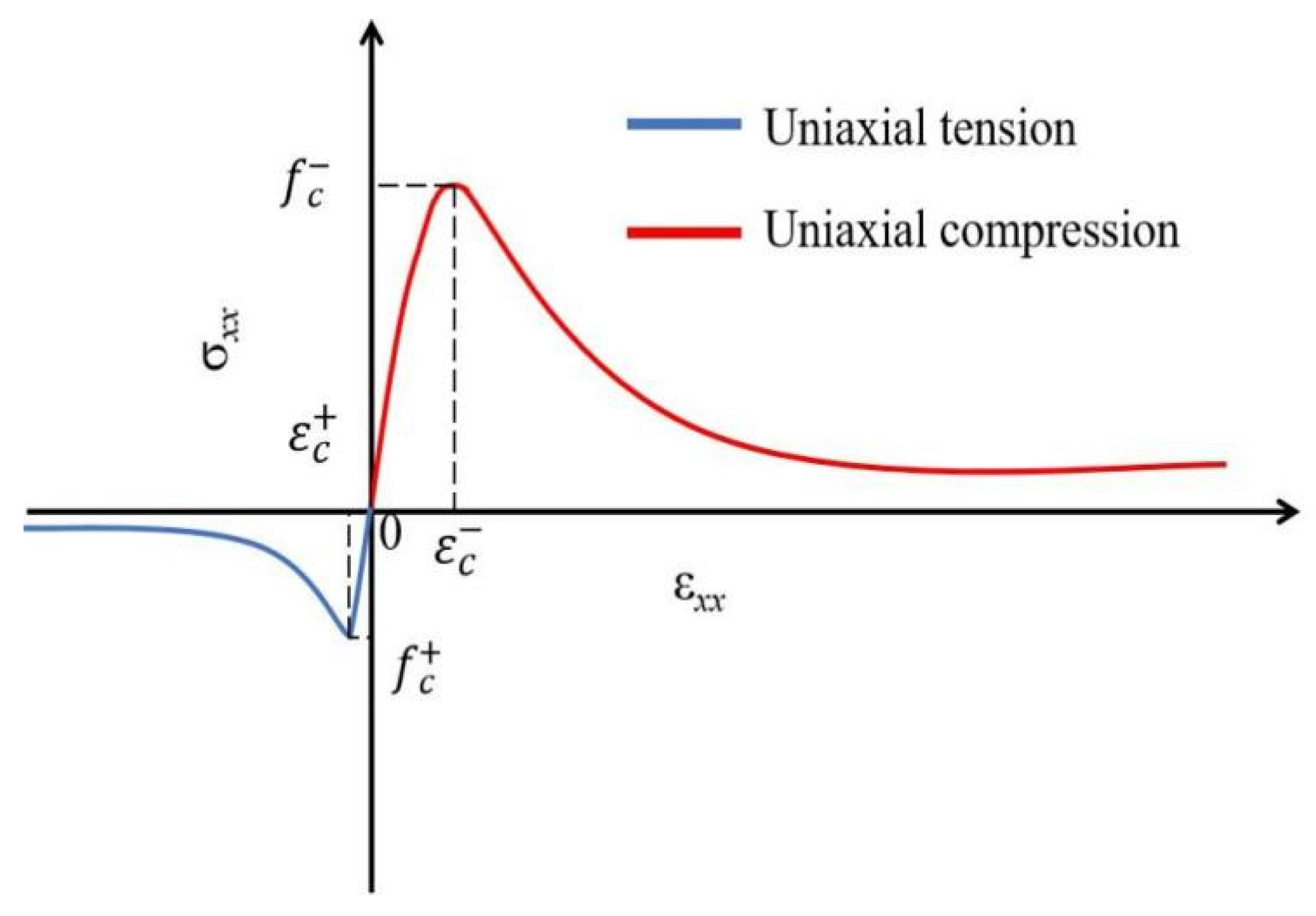

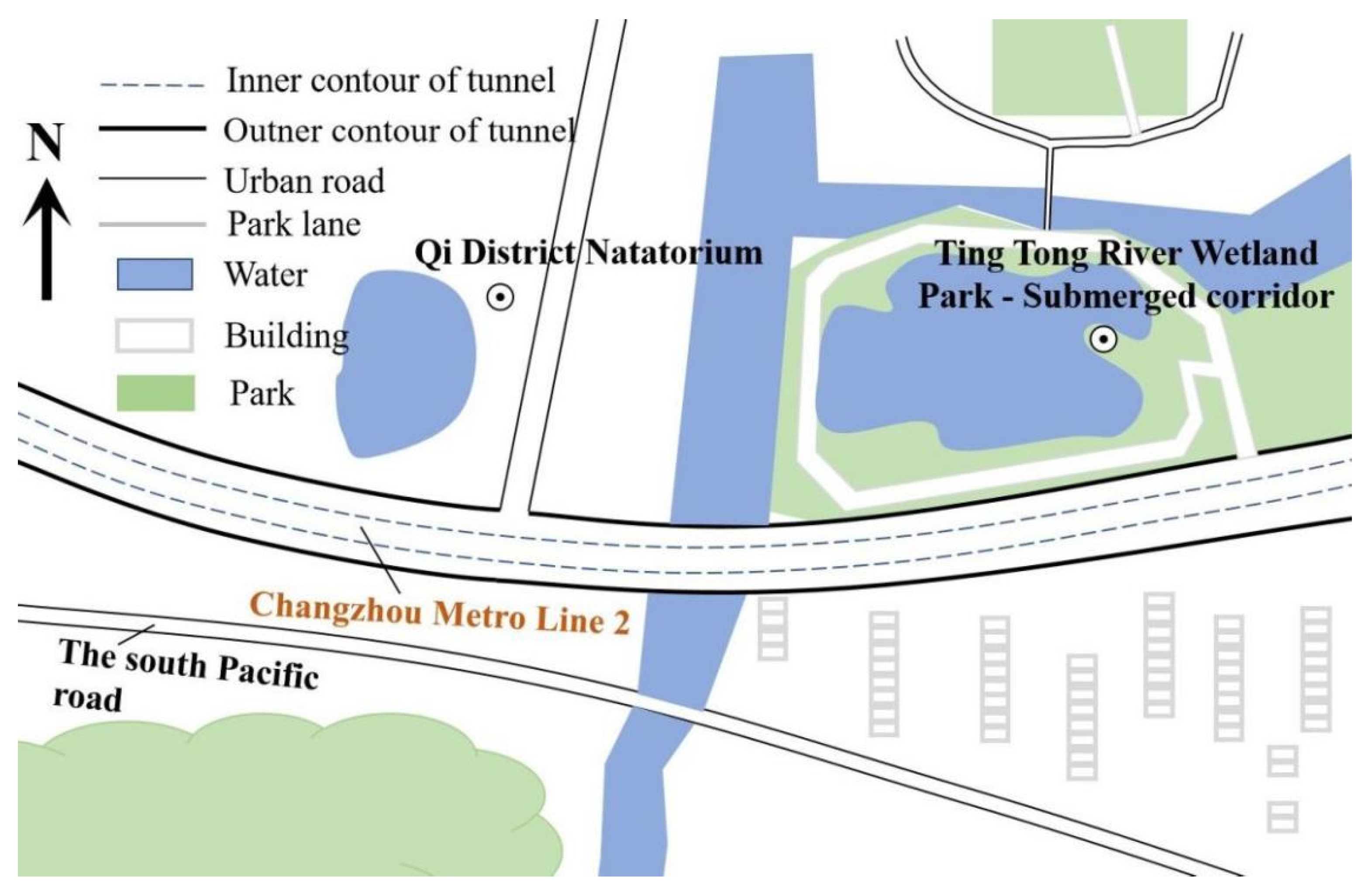

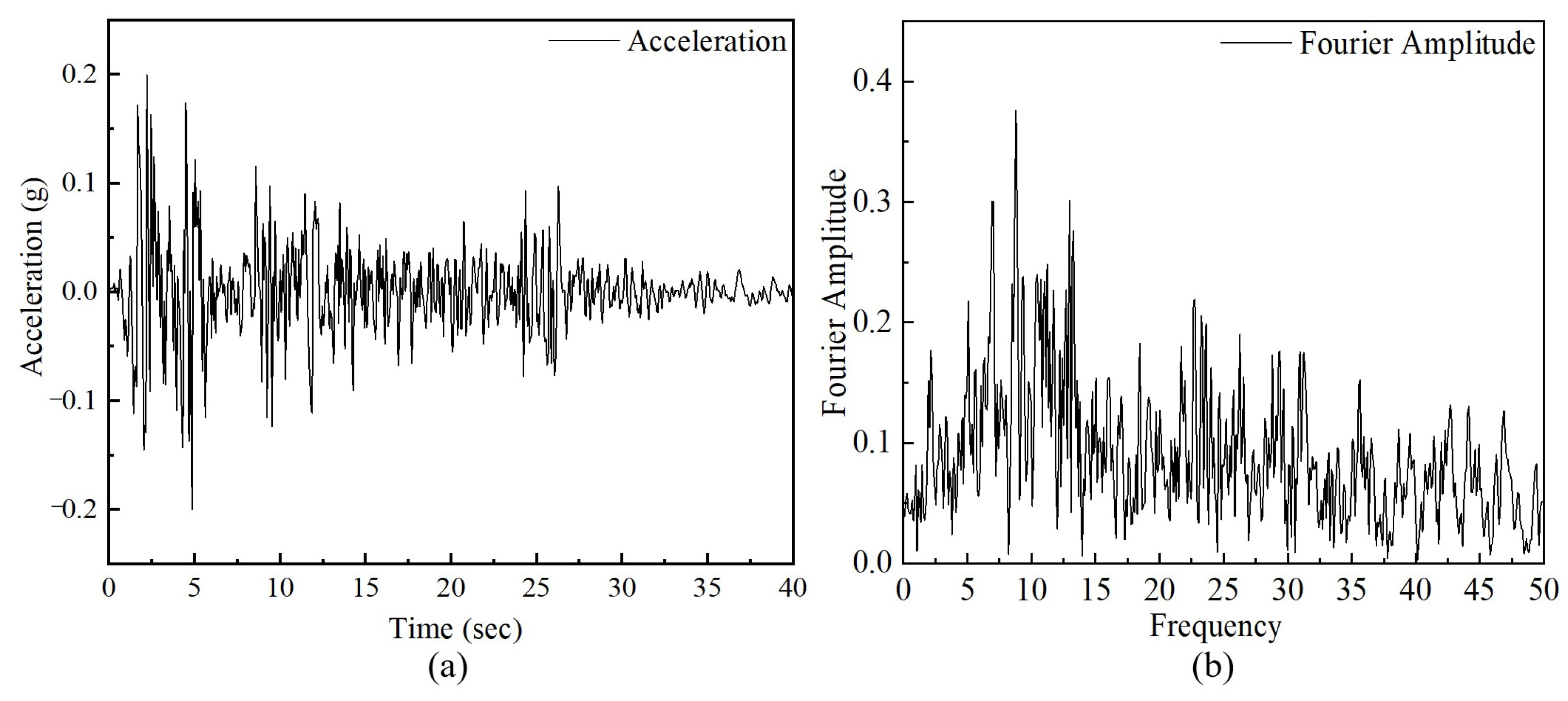

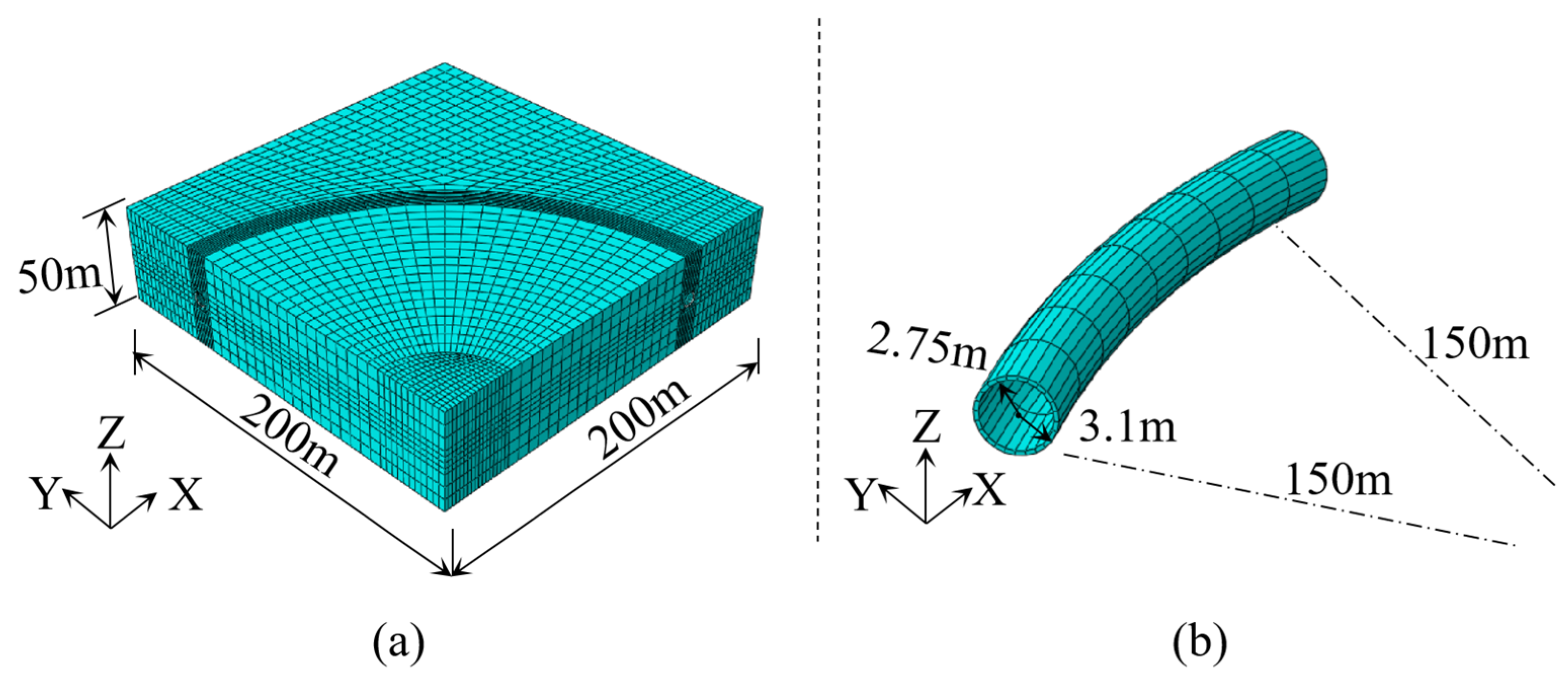
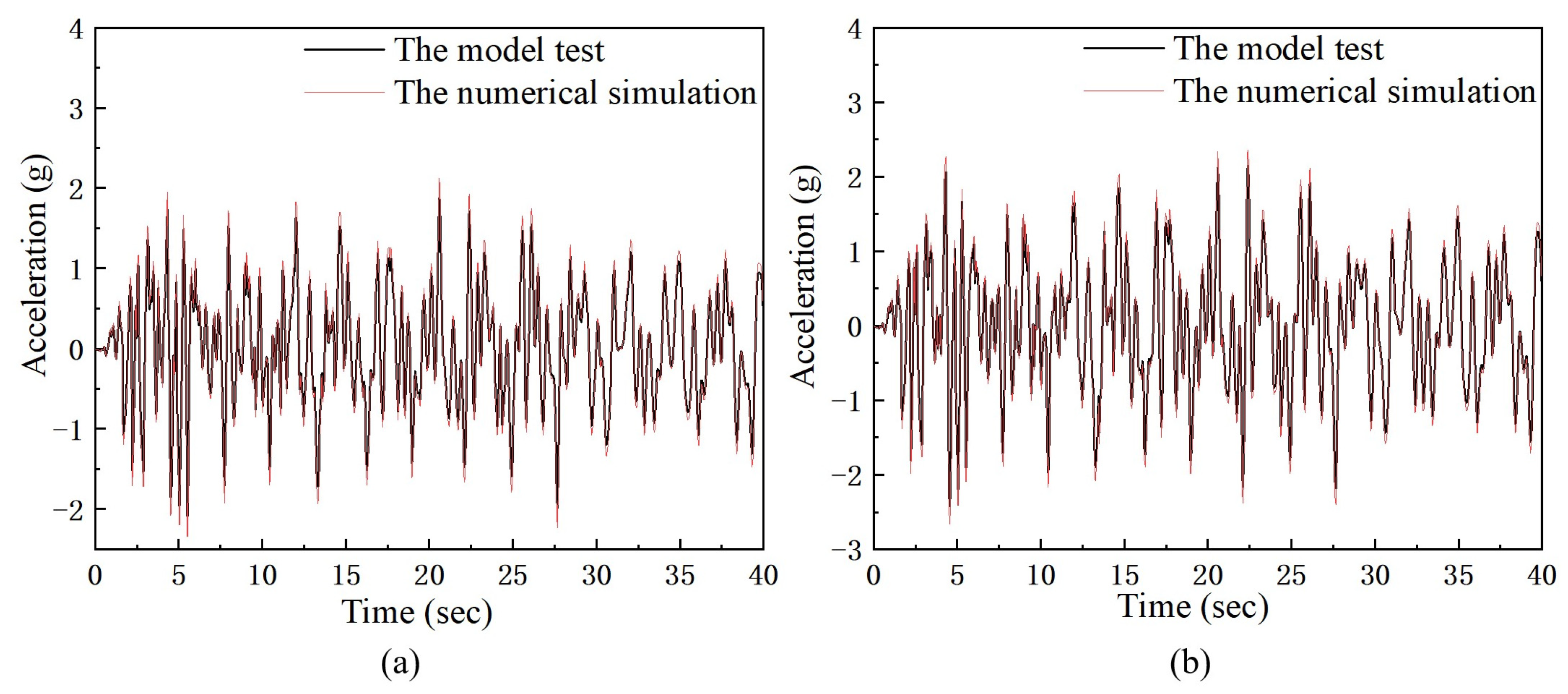

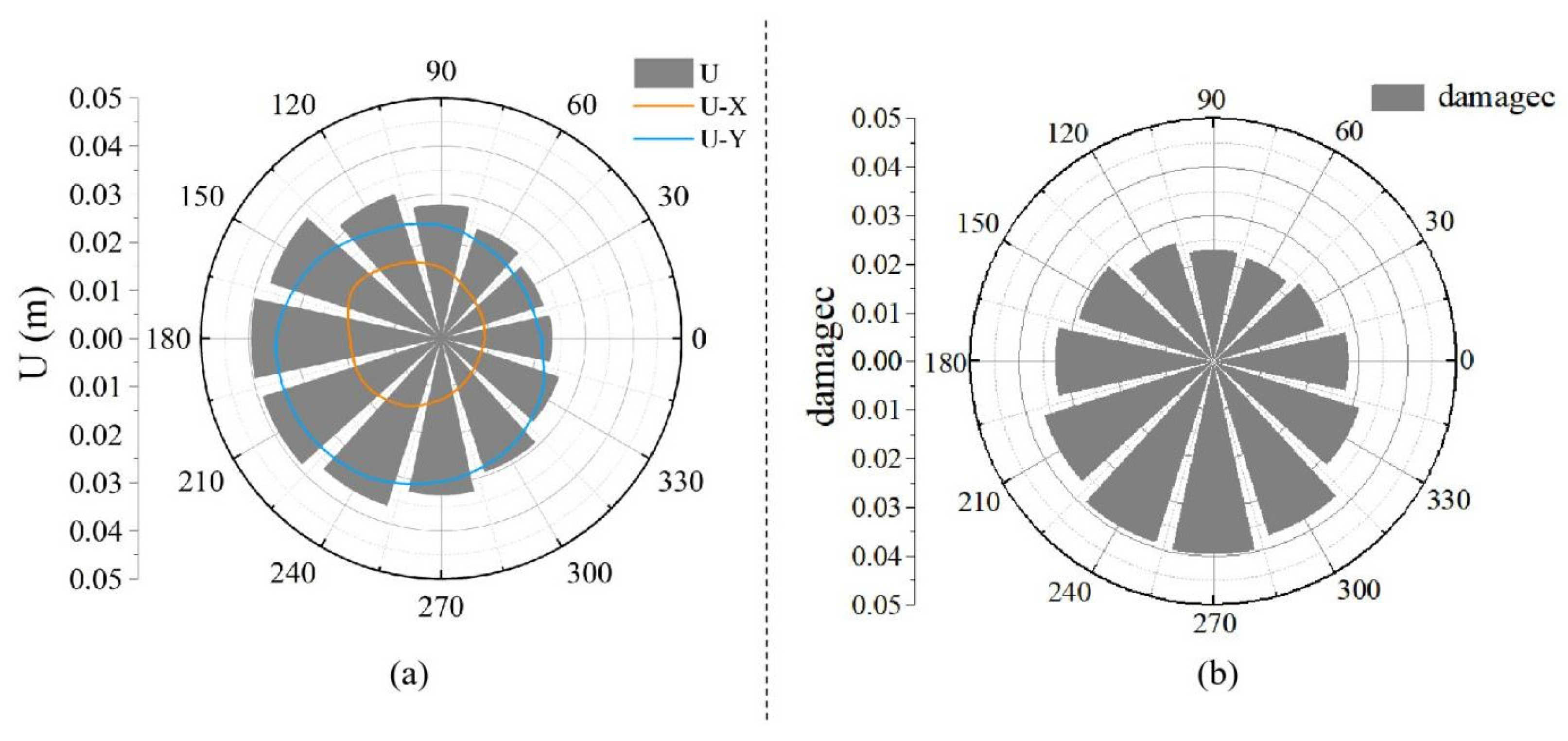
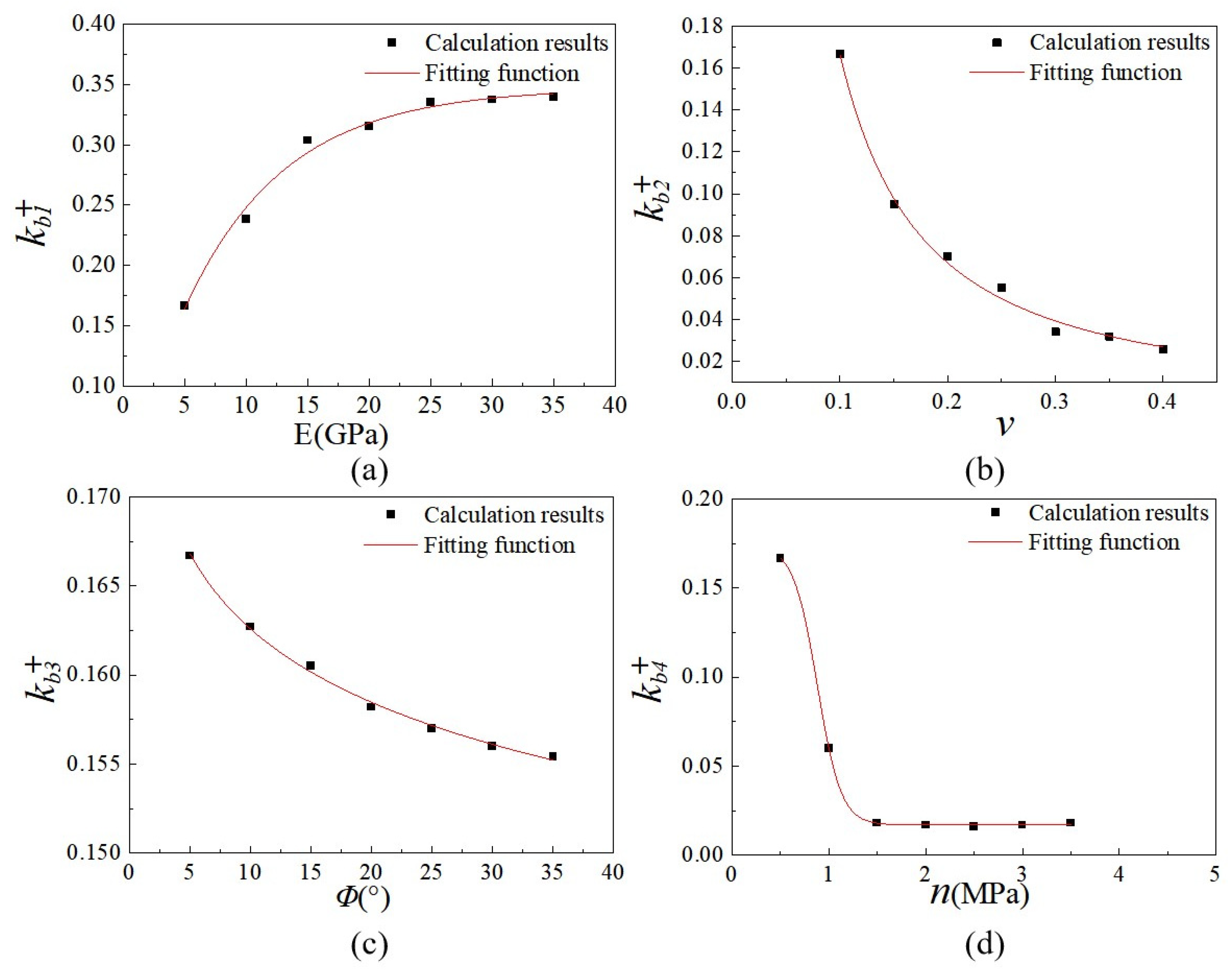
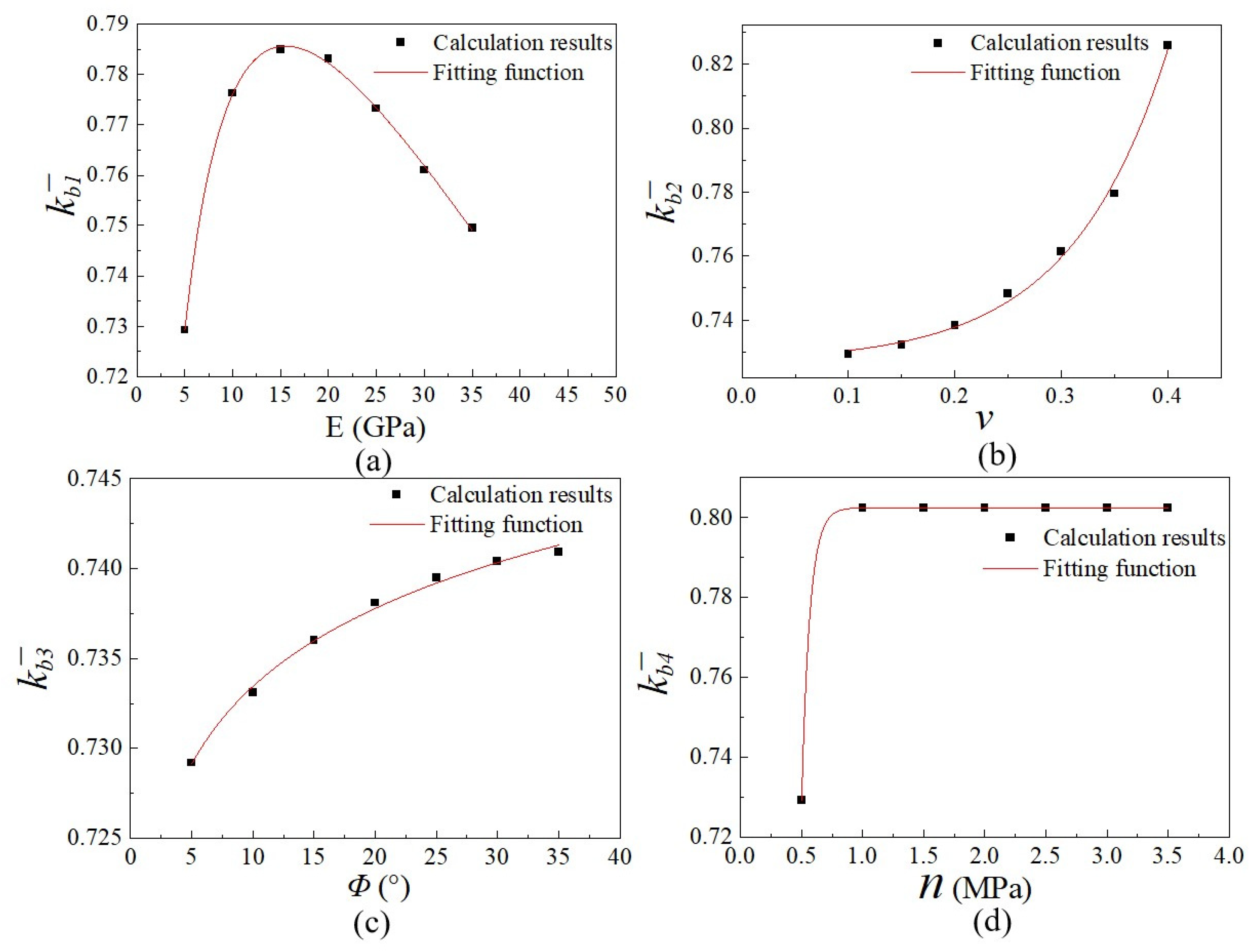
| Physical Quantity | Similarity | Similarity Ratio | ||
|---|---|---|---|---|
| Geometric properties | length | 1:100 | ||
| Material properties | density | Surrounding rock layer | 1:1 | |
| Curved tunnel | ||||
| elastic modulus | Surrounding rock layer | 1:100 | ||
| Curved tunnel | ||||
| Poisson’s ratio | 1:1 | |||
| friction angle | 1:1 | |||
| strain | 1:1 | |||
| stress | Surrounding rock layer | 1:100 | ||
| Curved tunnel | ||||
| Dynamic characteristics | frequency | 100 | ||
| time | 1:100 | |||
| speed | 10 | |||
| acceleration | 1 | |||
| Physical Quantity | Elastic Modulus E (GPa) | Poisson’s Ratio | Density ρ (kg·m3) | Friction Angle Φ (°) | Cohesion n (MPa) |
|---|---|---|---|---|---|
| Surrounding rock | 5–35 | 0.1–0.4 | 2100 | 5–35 | 0.5–3.5 |
| Lining | 45 | 0.2 | 2500 | - | - |
| Project | Elastic Modulus
GPa | Poisson’s Ratio | Friction Angle ° | Cohesion
MPa |
|---|---|---|---|---|
| 1 | 5 | 0.1 | 5 | 0.5 |
| 2 | 10 | 0.1 | 5 | 0.5 |
| 3 | 15 | 0.1 | 5 | 0.5 |
| 4 | 20 | 0.1 | 5 | 0.5 |
| 5 | 25 | 0.1 | 5 | 0.5 |
| 6 | 30 | 0.1 | 5 | 0.5 |
| 7 | 35 | 0.1 | 5 | 0.5 |
| 8 | 5 | 0.1 | 5 | 0.5 |
| 9 | 5 | 0.15 | 5 | 0.5 |
| 10 | 5 | 0.2 | 5 | 0.5 |
| 11 | 5 | 0.25 | 5 | 0.5 |
| 12 | 5 | 0.3 | 5 | 0.5 |
| 13 | 5 | 0.35 | 5 | 0.5 |
| 14 | 5 | 0.4 | 5 | 0.5 |
| 15 | 5 | 0.1 | 5 | 0.5 |
| 16 | 5 | 0.1 | 10 | 0.5 |
| 17 | 5 | 0.1 | 15 | 0.5 |
| 18 | 5 | 0.1 | 20 | 0.5 |
| 19 | 5 | 0.1 | 25 | 0.5 |
| 20 | 5 | 0.1 | 30 | 0.5 |
| 21 | 5 | 0.1 | 35 | 0.5 |
| 22 | 5 | 0.1 | 5 | 0.5 |
| 23 | 5 | 0.1 | 5 | 1 |
| 24 | 5 | 0.1 | 5 | 1.5 |
| 25 | 5 | 0.1 | 5 | 2 |
| 26 | 5 | 0.1 | 5 | 2.5 |
| 27 | 5 | 0.1 | 5 | 3 |
| Parameter Variables and the Value of | |||||||
|---|---|---|---|---|---|---|---|
| (GPa) | 5 | 10 | 15 | 20 | 25 | 30 | 35 |
| 0.1667 | 0.2381 | 0.3036 | 0.3155 | 0.3353 | 0.3373 | 0.3393 | |
| 0.7292 | 0.7763 | 0.7850 | 0.7832 | 0.7733 | 0.7610 | 0.7495 | |
| 0.1 | 0.15 | 0.2 | 0.25 | 0.3 | 0.35 | 0.4 | |
| 0.1667 | 0.095 | 0.0691 | 0.0551 | 0.0341 | 0.0319 | 0.0258 | |
| 0.7292 | 0.7323 | 0.7383 | 0.7482 | 0.7614 | 0.7795 | 0.8259 | |
| (°) | 5 | 10 | 15 | 20 | 25 | 30 | 35 |
| 0.1667 | 0.1627 | 0.1605 | 0.1582 | 0.1571 | 0.1599 | 0.1554 | |
| 0.7292 | 0.7331 | 0.736 | 0.7381 | 0.7395 | 0.7404 | 0.7409 | |
| (MPa) | 0.5 | 1 | 1.5 | 2.0 | 2.5 | 3.0 | 3.5 |
| 0.1667 | 0.0598 | 0.0179 | 0.0179 | 0.0179 | 0.0179 | 0.0179 | |
| 0.7292 | 0.8025 | 0.8025 | 0.8025 | 0.8025 | 0.8025 | 0.8025 | |
Disclaimer/Publisher’s Note: The statements, opinions and data contained in all publications are solely those of the individual author(s) and contributor(s) and not of MDPI and/or the editor(s). MDPI and/or the editor(s) disclaim responsibility for any injury to people or property resulting from any ideas, methods, instructions or products referred to in the content. |
© 2023 by the authors. Licensee MDPI, Basel, Switzerland. This article is an open access article distributed under the terms and conditions of the Creative Commons Attribution (CC BY) license (https://creativecommons.org/licenses/by/4.0/).
Share and Cite
Bu, S.; Feng, X.; Yao, L.; Yang, F.; Xie, Y.; Liu, S. Seismic Dynamic Response and Lining Damage Analysis of Curved Tunnel under Shallowly Buried Rock Strata. Sustainability 2023, 15, 4905. https://doi.org/10.3390/su15064905
Bu S, Feng X, Yao L, Yang F, Xie Y, Liu S. Seismic Dynamic Response and Lining Damage Analysis of Curved Tunnel under Shallowly Buried Rock Strata. Sustainability. 2023; 15(6):4905. https://doi.org/10.3390/su15064905
Chicago/Turabian StyleBu, Shijie, Xiaojiu Feng, Luyan Yao, Fujian Yang, Yongtian Xie, and Shaofeng Liu. 2023. "Seismic Dynamic Response and Lining Damage Analysis of Curved Tunnel under Shallowly Buried Rock Strata" Sustainability 15, no. 6: 4905. https://doi.org/10.3390/su15064905
APA StyleBu, S., Feng, X., Yao, L., Yang, F., Xie, Y., & Liu, S. (2023). Seismic Dynamic Response and Lining Damage Analysis of Curved Tunnel under Shallowly Buried Rock Strata. Sustainability, 15(6), 4905. https://doi.org/10.3390/su15064905








